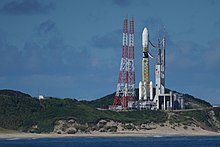
Back H-IIB Bulgarian H-IIB Catalan H-IIB Czech H-IIB German H-IIB Spanish H-IIB French H-IIB Galician H-II B (משגר לוויינים) HE एच-2बी Hindi H-IIB ID
 H-IIB No. F8 at the launch pad in September 2019 | |
| Function | Medium-lift launch vehicle |
|---|---|
| Manufacturer | Mitsubishi Heavy Industries |
| Country of origin | Japan |
| Cost per launch | US$112.5 million[1] |
| Size | |
| Height | 56.6 m (186 ft) |
| Diameter | 5.2 m (17 ft) |
| Mass | 531,000 kg (1,171,000 lb) |
| Stages | 2 |
| Capacity | |
| Payload to LEO | |
| Mass | 19,000 kg (42,000 lb)[2] |
| Payload to ISS (carrying the HTV) | |
| Mass | 16,500 kg (36,400 lb)[3] |
| Payload to GTO | |
| Mass | 8,000 kg (18,000 lb)[4] |
| Associated rockets | |
| Family | H-II family |
| Based on | H-II, H-IIA |
| Derivative work | H3 |
| Comparable | |
| Launch history | |
| Status | Retired |
| Launch sites | Tanegashima, LA-Y2 |
| Total launches | 9 |
| Success(es) | 9 |
| First flight | 10 September 2009 |
| Last flight | 20 May 2020 |
| Type of passengers/cargo | H-II Transfer Vehicle |
| Boosters – SRB-A3 | |
| No. boosters | 4 |
| Height | 15 m (49 ft) |
| Diameter | 2.5 m (8 ft 2 in) |
| Gross mass | 76,500 kg (168,700 lb) each |
| Propellant mass | 66,000 kg (146,000 lb) each |
| Maximum thrust | 2,305 kN (518,000 lbf) |
| Total thrust | 9,220 kN (2,070,000 lbf) |
| Specific impulse | 283.6 s (2.781 km/s) |
| Burn time | 114 seconds |
| Propellant | HTPB |
| First stage | |
| Height | 38 m (125 ft) |
| Diameter | 5.2 m (17 ft) |
| Gross mass | 202,000 kg (445,000 lb) |
| Propellant mass | 177,800 kg (392,000 lb) |
| Powered by | 2 × LE-7A |
| Maximum thrust | 2,196 kN (494,000 lbf) |
| Specific impulse | 440 seconds (4.3 km/s) |
| Burn time | 352 seconds |
| Propellant | LH2 / LOX |
| Second stage | |
| Height | 11 m (36 ft) |
| Diameter | 4.0 m (13.1 ft) |
| Gross mass | 20,000 kg (44,000 lb) |
| Propellant mass | 16,600 kg (36,600 lb) |
| Powered by | 1 × LE-5B |
| Maximum thrust | 137 kN (31,000 lbf) |
| Specific impulse | 448 s (4.39 km/s) |
| Burn time | 499 seconds |
| Propellant | LH2 / LOX |
H-IIB (H2B) was an expendable space launch system jointly developed by the Japanese government's space agency JAXA and Mitsubishi Heavy Industries. It was used to launch the H-II Transfer Vehicle (HTV, or Kōnotori) cargo spacecraft for the International Space Station. The H-IIB was a liquid-fueled rocket, with solid-fuel strap-on boosters and was launched from the Tanegashima Space Center in southern Japan. H-IIB made its first flight in 2009, and had made a total of nine flights through 2020 with no failures.
H-IIB was able to carry a payload of up to 8,000 kg (18,000 lb) to Geostationary transfer orbit (GTO),[4] compared with the payload of 4000–6000 kg for the H-IIA, a predecessor design. Its performance to low Earth orbit (LEO) was sufficient for the 16,500 kg (36,400 lb) H-II Transfer Vehicle (HTV).[4] The first H-IIB was launched in September 2009 and the last H-IIB was launched in May 2020.[4]
- ^ "Surplus Missile Motors: Sale Price Drives Potential Effects on DOD and Commercial Launch Providers". Government Accountability Office. 16 August 2017. Retrieved 8 September 2024.
- ^ SASAKI, Hiroshi; IMADA, Takane; TAKATA, Shinichi (2009). "Development Plan for Future Mission from HTV System". Transactions of the Japan Society for Aeronautical and Space Sciences, Space Technology Japan. 7 (ists26): Tk_77–Tk_82. doi:10.2322/tstj.7.Tk_77. ISSN 1347-3840.
- ^ "About H-IIB Launch Vehicle". Japan Aerospace Exploration Agency. JAXA. Retrieved 18 September 2019.
- ^ a b c d Krebs, Gunter. "H-2B". Gunter's Space Page. Retrieved 28 January 2017.